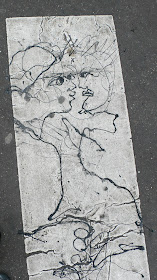Monday, November 23, 2015
Wednesday, November 18, 2015
TRIANGULATION
Deux c'est bien, trois c'est trop.
Two's company, three's a crowd.
A French Education is admittedly taking liberties in interpreting this vintage street artwork, circa 2009, of Versailles artist Emmanuel Braudeau...
©2015 P.B. Lecron
Tuesday, November 17, 2015
RESILIENCE
Sous le ciel de Paris
In a light rain, last night became the first of three evenings that the Eiffel Tower will be illuminated in the highly symbolic colors of blue, white, and red. Blazons of Paris featuring the emblem of Paris, a schooner, flank the city's Latin devise, Fluctuat nec mergitur. Rallying resilience, and today resistance, the motto translates into French: "Il est battue par les flots mais ne sombre pas." Battered by the waves, but not sunk. Since the late 12th century the choice of a boat with sails as an emblem for the city has underscored the importance of the Seine as a source of food, transport, and commerce to Parisians.
Vocabulary
les flots: waves, flood tides
To listen to Edith Piaf sing Sous le Ciel de Paris click here.
©2015 P.B. Lecron
Sunday, November 15, 2015
KEEPING HEART
Ce qui fait du bien dans le malheur, c'est un coeur plein de courage. -- Plautus
What does one well in moments of tragedy is a heart full of courage.
Well-weathered shutters with one of the most common of decorative cut-outs are a reminder that the geometric heart-shape has a long history from first simply depicting foliage, to eventually being associated with the human heart and courage, to later being used as a symbol for romantic love.
The above citation, translated into French, is from the ancient Roman dramatist, Plautus, who evolved from working as a theatre stagehand to being one of antique Rome's favorite playwrights.
Photo taken in Saint-Valéry-sur-Somme
Vocabulary
le malheur: adversity, misfortune, tragedy
un volet: a shutter
©2015 P.B. Lecron
Saturday, November 14, 2015
Friday, November 13, 2015
Thursday, November 12, 2015
Wednesday, November 11, 2015
AM I CORNFLOWER BLUE?
Les Bleuets--Fleurs de France
Le Bleuet or cornflower is the French symbol of remembrance of young soldiers who gave their lives for France during WWI. During that war, new recruits were issued light blue uniforms after the realization that the bright red trousers worn at the beginning of WWI made the French soldiers easy targets. Since 1916 cloth and paper cornflowers have been sold, just like the Remembrance Day poppies in England and America, to benefit veterans and their widows and orphans. The above photo featuring delicate cornflowers and stylized goldfinches, or German distelfinks, is of recent wallpaper in a small ante-room of the Château de la Roche-Guyon.
Remembering on Armistice Day
©2015 P.B. Lecron
Tuesday, November 10, 2015
PLUS BELLE, LA POUBELLE
Hygiene with Eugène
It was a préfet by the name of Eugène Poubelle who in 1883 first ordered that property owners of apartment buildings in Paris provide their tenants with regimented, closed receptacles in which to dispose of their household trash, so that there could be an organized trash collection by the city. It didn't take long for Parisians to begin referring to the receptacles as "poubelles." A fortuitous happenstance considering that the indispensable hygiene measure was indeed a step in rendering the city more beautiful. The above trash bin or poubelle, although not intended for household trash, is a model selected by the medieval port city of Saint-Valèry-sur-Somme and shows how discretely and nicely such urban amenities can fit into the landscape.
©2015 P.B. Lecron
Monday, November 9, 2015
Monday, November 2, 2015
WHAT'S UP?
On en est où?
Urban street art on ventilation ducts of the Centre Pompidou "pop" up a building adjacent to the glass and steel art center. Through the decades the art center's pioneering 1970's architecture has become something that we simply have had to put up with, then have grown accustomed to.Expressions
Qu'est-ce qui se passe? Que se passe-t-il? Quoi de neuf? On en est où? : What's up?
©2015 P.B. Lecron












